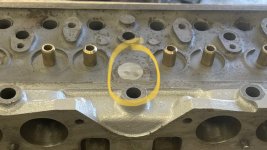Offline
Yikes, what happened to my cylinder head? I had it cleaned two years ago, new valves and guides, checked and given report of good health. Since then, it sat in my Arizona garage in a sealed plastic bag for two years. It's possible there was a four-month period where the bag wasn't sealed very well. Anyway, I just torqued the head to the block and was all ready to congratulate myself when I noticed an odd spot on that core plug you see in the pic. I poked at it, and it's like cardboard. I could probably just knock it with a few taps.
But, of course, the issue is what to do. I see Moss sells this plug, but is this a sign of severe internal rust? Is this readily fixable and commonplace? I can't imagine this is a home project given the forces within an operating cylinder head, but I am fortunate enough to have a friend with a full machine shop at his house and he's quite a bit more than just handy.
Have any of you had experience with this sort of issue before. Definitely a first for me.
 Any advice appreciated.
Any advice appreciated.
Thanks all.
But, of course, the issue is what to do. I see Moss sells this plug, but is this a sign of severe internal rust? Is this readily fixable and commonplace? I can't imagine this is a home project given the forces within an operating cylinder head, but I am fortunate enough to have a friend with a full machine shop at his house and he's quite a bit more than just handy.
Have any of you had experience with this sort of issue before. Definitely a first for me.
Thanks all.
Last edited:

 Hi Guest!
Hi Guest!

 smilie in place of the real @
smilie in place of the real @
 Pretty Please - add it to our Events forum(s) and add to the calendar! >>
Pretty Please - add it to our Events forum(s) and add to the calendar! >> 



